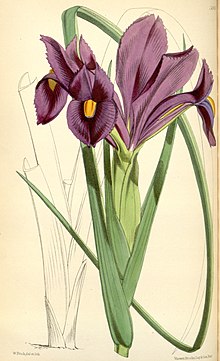Species of plant in the family Iridaceae
Iris filifolia Iris filifolia Iris Xiphium bulbous perennial from North Africa and Europe. It has thin leaves, summer flowers in shades of red-purple.
Description
It has 3 mm wide leaves,[ 4] [ 5] [ 6] [ 5] [ 6] [ 7] [ 4] [ 6] [ 8]
Biochemistry
As most irises are diploid , having two sets of chromosomes , this can be used to identify hybrids and classification of groupings.[ 6] [ 8]
Taxonomy
Its name means 'thread-leaved iris'.[ 9]
In Gibraltar , it is also known as the 'Narrow-leaved Purple Iris'.[ 10]
It is often mistakenly called 'Spanish Iris'.[ 11] Iris xiphium
In 1842, it was first described by Pierre Edmond Boissier in 'Voyage botanique en Espagne' Vol 2, on page 602.[ 12] [ 13] Curtis's Botanical Magazine No.5929 as 'Xiphion filifolium'.[ 3]
It was recorded in the Catalogue of Life in 2011,[ 2] United States Department of Agriculture Agricultural Research Service on 4 April 2003, and updated on 14 November 2005.[ 14]
Distribution and habitat
It is native to temperate regions of North Africa and Europe .[ 14]
Range
It was found originally on Sierra de Mijas ,[ 15] Spain , at 3,000–4,000 ft (910–1,220 m) above sea level.[ 3]
It is found within Africa, in Morocco , (near Tangier ,[ 6] [ 8] Spain ,[ 14] [ 6] [ 8] Gibraltar .[ 10] [ 8]
Habitat
Iris filifolia likes to grow in sandy areas.[ 16]
Cultivation
It is best grown in a bulb frame in the UK.[ 17]
It is known to be toxic like other bulbs in the genus.[ 18]
Cultivars
Several known cultivars are;[ 3]
'A. Bloemaard' (dark blue)[ 19]
'Filifolia'
'Filifolia Alba'
'Filifolia Elizabeth'
'Filifolia Imperator'
'Filifolia Praecox'
'Latifolia'
'Queen Of Gazelles'
'Rex'
Hybrids
Iris filifolia var. latifolia (Foster) wide leaved variant [ 5] Iris filifolia var. filifolia (Boiss) and thread-like leaved variant,[ 5]
References
^ Crespo, M.B. (2017). "Iris filifolia " . IUCN Red List of Threatened Species 2017 : e.T13161707A65077657. doi :10.2305/IUCN.UK.2017-3.RLTS.T13161707A65077657.en . Retrieved 20 November 2021 . ^ a b Roskov Y.; Kunze T.; Orrell T.; et al., eds. (2011). "Species 2000 & ITIS Catalogue of Life: 2014 Annual Checklist" . Species 2000: Reading, UK. Retrieved 29 July 2014 . ^ a b c d "(SPEC) Iris filifolia Boiss" . wiki.irises.org (American Iris Society). Retrieved 29 July 2014 .^ a b James Cullen, Sabina G. Knees, H. Suzanne Cubey (Editors) The European Garden Flora Flowering Plants: A Manual for the Identification Google Books
^ a b c d British Iris Society (1997) A Guide to Species Irises: Their Identification and Cultivation Google Books
^ a b c d e f Austin, Claire (2005). Irises: A Gardener's Encyclopedia . Timber Press, Incorporated. ISBN 978-0881927306 OL 8176432M . ^ "Iris filifolia Boiss" . iridaceae.e-monocot.org. Archived from the original on 4 March 2016. Retrieved 21 July 2014 .^ a b c d e "Iris summary" (PDF) . pacificbulbsociety.org. 14 April 2014. Retrieved 8 February 2018 .^ Ivan Nikolaevič Filipév and Jacobus Hermanus Schuurmans Stekhoven A Manual of Agricultural Helminthology Google Books
^ a b Linares, Leslie L. "Gibraltar Flora" . www.gibraltar.gov.gi. Retrieved 29 July 2014 . ^ "Iris filifolia" . www.webster-dictionary.org. Retrieved 30 July 2014 .^ "Iris filifolia Boiss" . apps.kew.org. Retrieved 30 July 2014 .^ Dykes, William R. "Dykes on Irises (Reprints of Journals)" (PDF) . www.beardlessiris.org. Retrieved 30 July 2014 . ^ a b c "Iris filifolia " . Germplasm Resources Information Network Agricultural Research Service , United States Department of Agriculture . Retrieved 8 February 2018 .^ CRESPO VILLALBA, Manuel B. (2012). "Nomenclatural Types OF Iberian Irises (Iris and Related Genera, Iridaceae)" (PDF) . Retrieved 30 July 2014 . ^ Rosenberg, Kristin. "Flowers of Gibraltar" . www.unicover.com. Archived from the original on 9 February 2018. Retrieved 29 July 2014 . ^ Cassidy, G.E.; Linnegar, S. (1987). Growing Irises (Revised ed.). Bromley: Christopher Helm. p. 74. ISBN 0-88192-089-4 ^ "Iris filifolia - Boiss" . www.pfaf.org. Retrieved 30 July 2014 .^ Griffiths, David (April 1928). "Production of Certain Iris Bulbs" . Retrieved 30 July 2014 .
Other sources
Fennane, M. & M. I. Tattou 1998. Catalogue des plantes vasculaires rares, menacées ou endémiques du Maroc (Bocconea) 8:205.
Jahandiez, E. & R. Maire Catalogue des plantes du Maroc. 1931-1941 (L Maroc)
Maire, R. C. J. E. et al. Flore de l'Afrique du Nord. 1952- (F Afr Nord)
Mathew, B. The Iris. 1981 (Iris) 136.
Tutin, T. G. et al., eds. Flora europaea. 1964-1980 (F Eur)
External links
Iris filifolia at Wikimedia Commons
Iris filifolia at Wikispecies


